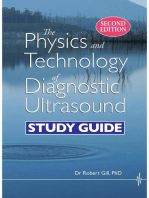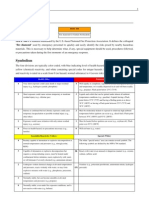A. Safety Harnesses (SANS 50361:2003 Personal Protective Equipment Against Falls From A Height - Full Body Harness)
A. Safety Harnesses (SANS 50361:2003 Personal Protective Equipment Against Falls From A Height - Full Body Harness)
Uploaded by
ashielanieCopyright:
Available Formats
A. Safety Harnesses (SANS 50361:2003 Personal Protective Equipment Against Falls From A Height - Full Body Harness)
A. Safety Harnesses (SANS 50361:2003 Personal Protective Equipment Against Falls From A Height - Full Body Harness)
Uploaded by
ashielanieOriginal Description:
Original Title
Copyright
Available Formats
Share this document
Did you find this document useful?
Is this content inappropriate?
Copyright:
Available Formats
A. Safety Harnesses (SANS 50361:2003 Personal Protective Equipment Against Falls From A Height - Full Body Harness)
A. Safety Harnesses (SANS 50361:2003 Personal Protective Equipment Against Falls From A Height - Full Body Harness)
Uploaded by
ashielanieCopyright:
Available Formats
11/13/2017
PO Box 890177 Lyndhurst, 2106
Tel: (011) 264 0447
Fax: (086) 583 4814
Hamsun are reliant on product suppliers and manufacturers for product information and bear no responsibility for any inaccuracies contained in this
catalogue. All prices exclude VAT and are subject to change without notice. Supply is subject to stock availability.
A. Safety Harnesses (SANS 50361:2003 Personal protective equipment against falls from a height - Full
Body Harness)
Scope: Specifies material requirements and testing of full body harnesses used as components in fall arrest systems as specified in SANS 50363.
A work positioning belt as specified by SANS 50358 may be incorporated into the full body harness design.
Definition of a full body harness: A body support device used primarily for fall arrest purposes. Typically used with either a lanyard set (lanyards
and energy absorber) or retractable type fall arrestor. A full body harness comprises webbing straps, buckles, connectors and other elements
suitably constructed to support the whole body of a person during a fall and after the arrest of a fall.
Definition of primary straps: The straps on the harness which directly support the weight of the body during a fall and after the arrest of a fall.
Typically the shoulder straps, sit strap and leg straps on the harness.
Definition of secondary straps: All of the harness webbing not directly supporting the weight of the body during a fall and after the arrest of a fall.
Typically, the chest strap and waist strap.
Definition of attachment element: Designated connecting point for components like the energy absorbing lanyard set or the work positioning
lanyard.
Materials: Webbing and thread used in sewing must be made from virgin filament or multifilament synthetic fibres with a breaking tenacity of at
least 0,6N/tex.
Materials: Thread used in sewing together the components of the full body harness webbing must be of a contrasting colour to the webbing used
to facilitate visual inspection.
Design: The full body harness must fit the wearer and suitable means of adjustment must be provided. However straps may not loosen by
themselves.
Design: Primary straps must be at least 40mm wide, and secondary straps at least 20mm wide.
Design: The fall arrest element (D-ring) to which the fall arrest system is attached must be placed in such a way when worn by the user that it
remains above the centre of gravity of the user. For example at the chest in front or dorsal position (shoulders) at back.
Design: It must always be possible to visually inspect every component of the full body harness.
Static strength test: The full body harness is attached to an apparatus that allows a test load of 15kN (approximately 1500kg) to be applied to that
harness between the attachment element for fall arrest and the harness webbing worn by a test dummy. The test is passed if the full body harness
does not release the test dummy.
Dynamic performance drop test: The full body harness is fitted to a drop test dummy of 100kg in mass and dropped a free fall distance of 4
metres while attached to a static lanyard at the fall arrest attachment element. One drop test is conducted with the dummy oriented feet first and a
second test with the dummy oriented head first to simulate a worst case scenario fall. To pass the test the full body harness may not release the
dummy. In addition when the fall is arrested and the dummy at rest the dummy must have come to rest in a head up position (the angle between
the longitudinal axis of the dorsal plane and the vertical must not exceed 50 degrees).
1/1
You might also like
- Nissan Forklift Diesel 2-3,5 Ton Service Manual PDFDocument12 pagesNissan Forklift Diesel 2-3,5 Ton Service Manual PDFashielanie20% (5)
- Nissan Forklift Diesel 2-3,5 Ton Service Manual PDFDocument12 pagesNissan Forklift Diesel 2-3,5 Ton Service Manual PDFashielanie20% (5)
- Kubota v3600 Engine ManualDocument203 pagesKubota v3600 Engine Manualashielanie94% (17)
- Planilha Manuais Abcdpdf PDF para ExcelDocument38 pagesPlanilha Manuais Abcdpdf PDF para ExcelTeodoro Marçal100% (1)
- 10-Audi A3 QSB WebDocument135 pages10-Audi A3 QSB Webashielanie100% (3)
- BST ChecklistDocument3 pagesBST ChecklistBailey100% (1)
- Load Bearing Parts:: Max. 300 MMDocument1 pageLoad Bearing Parts:: Max. 300 MMMauricio GaviriaNo ratings yet
- T-Tape Foreskin Restoration PDFDocument11 pagesT-Tape Foreskin Restoration PDFValerie SandersNo ratings yet
- User Manual of Bed FoshongDocument18 pagesUser Manual of Bed FoshongMed SamoualNo ratings yet
- EHQS-TBT-49-Safety HarnessesDocument3 pagesEHQS-TBT-49-Safety HarnessesCristi CatrinoiuNo ratings yet
- Guia de Ensamble FlexifloatDocument12 pagesGuia de Ensamble FlexifloatJesus TapiaNo ratings yet
- Fabric Conveyor Belts Installation and Maintenance GuideDocument16 pagesFabric Conveyor Belts Installation and Maintenance Guidejonodo89100% (2)
- The Physics and Technology of Diagnostic Ultrasound: Study Guide (Second Edition)From EverandThe Physics and Technology of Diagnostic Ultrasound: Study Guide (Second Edition)No ratings yet
- MB Om 926Document2 pagesMB Om 926sinter-musicNo ratings yet
- PFAsDocument24 pagesPFAsAlexandria RaiNo ratings yet
- OrthopedicCastsAndSplints3 PDFDocument363 pagesOrthopedicCastsAndSplints3 PDFLuisa Paula LioanagNo ratings yet
- Quick Card: What You Need To KnowDocument2 pagesQuick Card: What You Need To KnowRaffer Asis MorañoNo ratings yet
- OSHA Safety Harness RequirementDocument3 pagesOSHA Safety Harness RequirementJecel AbayataNo ratings yet
- Descender Equipment AG 10 EN 341 CE 0158Document9 pagesDescender Equipment AG 10 EN 341 CE 0158imadNo ratings yet
- FallPrevention2014 QuickCard PDFDocument2 pagesFallPrevention2014 QuickCard PDFRaffer Asis MorañoNo ratings yet
- 19 - Suspended Scaffolding Construction Major Program Points 075Document12 pages19 - Suspended Scaffolding Construction Major Program Points 075BensonNo ratings yet
- Fall Protection TRAINININGDocument20 pagesFall Protection TRAINININGJaime de la Gala100% (1)
- Frequently Addressed Topics in Fall Protection: PerspectivesDocument6 pagesFrequently Addressed Topics in Fall Protection: Perspectivesk.m.ariful islamNo ratings yet
- Fall Protection PDFDocument13 pagesFall Protection PDFmohammad waqasNo ratings yet
- Ilbe User CardDocument2 pagesIlbe User CardRicky ReedNo ratings yet
- Owner'S Assembly and Operating ManualDocument44 pagesOwner'S Assembly and Operating Manualphanor1No ratings yet
- Fusion FusionEasy Eng 2010Document5 pagesFusion FusionEasy Eng 2010javiernar08No ratings yet
- Gliders For Real Pilots: IndependenceDocument6 pagesGliders For Real Pilots: Independencejaviernar08No ratings yet
- FALL ProtectionDocument60 pagesFALL ProtectionKhaled AlshomaliNo ratings yet
- UCLA Upper Extremity Amputations Manual - Sholder ProsthesisDocument39 pagesUCLA Upper Extremity Amputations Manual - Sholder ProsthesisAlaa SalamNo ratings yet
- Wet Ability & Tensile Strength TestsDocument14 pagesWet Ability & Tensile Strength TestsDeepthi channaNo ratings yet
- Fall Protection Toolbox Talk - Spanish FINAL OSHA Reviewed 8-27-13Document4 pagesFall Protection Toolbox Talk - Spanish FINAL OSHA Reviewed 8-27-13Alex ZapataNo ratings yet
- WAH 01 Working at Height Slide Presentation SSP.Document87 pagesWAH 01 Working at Height Slide Presentation SSP.Liya Staari100% (4)
- 2.5 Fall ProtectionDocument52 pages2.5 Fall ProtectionjantskieNo ratings yet
- 06-Fall Protection Baton RougeDocument52 pages06-Fall Protection Baton RougeLê Đức CườngNo ratings yet
- Suspension Trauma Relief Straps FlyerDocument1 pageSuspension Trauma Relief Straps FlyerNirooban VigneswaranNo ratings yet
- RLA - The Foundations of Rescue and Rigging Anchors Systems - EbookDocument19 pagesRLA - The Foundations of Rescue and Rigging Anchors Systems - EbookCarlos SantosNo ratings yet
- TRX QuickstartManualDocument16 pagesTRX QuickstartManualWalter Thompson100% (5)
- KS7710-13 - VERTICAL LIFELINE WEB - Manual-MinDocument13 pagesKS7710-13 - VERTICAL LIFELINE WEB - Manual-Mintyler CLausNo ratings yet
- TRX Quick Start ManualDocument15 pagesTRX Quick Start Manuallancillotto100% (1)
- ManualDocument16 pagesManualAnwar AliNo ratings yet
- INS119A RevC Carriere Motion ClassII Correction Appliance PDFDocument15 pagesINS119A RevC Carriere Motion ClassII Correction Appliance PDFchad smartNo ratings yet
- Care of Belting 02Document9 pagesCare of Belting 02jonodo89No ratings yet
- SCAFFOLDDocument12 pagesSCAFFOLDMIAN MATEENNo ratings yet
- User Manual Wire Rope SlingDocument4 pagesUser Manual Wire Rope SlingRashid Ghani100% (1)
- Khaye:: Traction: Is The Act of Pulling or Drawing Which Is Associated With Counter TractionDocument4 pagesKhaye:: Traction: Is The Act of Pulling or Drawing Which Is Associated With Counter TractionChloe MorningstarNo ratings yet
- Working at Height Rules - EngDocument3 pagesWorking at Height Rules - EngAlexander KlmNo ratings yet
- User'S Manual: CautionDocument39 pagesUser'S Manual: CautionJohn SmithNo ratings yet
- Fall ProtectionDocument12 pagesFall ProtectionjawehNo ratings yet
- Manual ChevroletDocument40 pagesManual ChevroletMilton CachuchisNo ratings yet
- Weight Bench Exerciser User's Manual: CautionDocument24 pagesWeight Bench Exerciser User's Manual: CautionmehralsmenschNo ratings yet
- 2.balance Skeletal TractionDocument18 pages2.balance Skeletal TractionKatrina Ponce75% (4)
- Balance Skeletal Traction. BST ProcedureDocument4 pagesBalance Skeletal Traction. BST Procedurehannjazz80% (10)
- Installation Manual: MASTERLINE Extreme HybridDocument15 pagesInstallation Manual: MASTERLINE Extreme HybridCarzrental RentalNo ratings yet
- Fallhaz Handouts PDFDocument10 pagesFallhaz Handouts PDFAndres Cedeno TutivenNo ratings yet
- Fall Protection 1Document2 pagesFall Protection 1Cecil VillarealNo ratings yet
- Horizontal LifeLine InstructionsDocument8 pagesHorizontal LifeLine InstructionsjarnebergNo ratings yet
- User'S Manual: Questions?Document33 pagesUser'S Manual: Questions?John SmithNo ratings yet
- 1 Fall Hazards Trainer GuideDocument39 pages1 Fall Hazards Trainer Guidedroffilcz27100% (1)
- Elevated Work : Presentation OnDocument33 pagesElevated Work : Presentation OnVasant Kumar VarmaNo ratings yet
- Scaffolding ProgramDocument9 pagesScaffolding ProgramGothy GamingNo ratings yet
- 13023SV - Manual - Revised - V2 - 3 - 9 Drive LiftDocument36 pages13023SV - Manual - Revised - V2 - 3 - 9 Drive Liftertt5t5No ratings yet
- Genie Par CataloDocument3 pagesGenie Par CataloashielanieNo ratings yet
- Custo ItsAllHereWrench FDocument1 pageCusto ItsAllHereWrench FashielanieNo ratings yet
- Tydel PartsDocument3 pagesTydel PartsashielanieNo ratings yet
- Burqui 2019Document38 pagesBurqui 2019ashielanieNo ratings yet
- Nissan Forklift CheckDocument82 pagesNissan Forklift CheckashielanieNo ratings yet
- Standard Equipment/Optional Equipment FeaturesDocument2 pagesStandard Equipment/Optional Equipment FeaturesashielanieNo ratings yet
- Tydel Parts 2Document6 pagesTydel Parts 2ashielanieNo ratings yet
- Bostik Super Gasket: Safety Data SheetDocument5 pagesBostik Super Gasket: Safety Data SheetashielanieNo ratings yet
- E400AJP: Articulating Boom LiftsDocument2 pagesE400AJP: Articulating Boom LiftsashielanieNo ratings yet
- It It It ItDocument64 pagesIt It It ItashielanieNo ratings yet
- JBL - Ctrl14C - T v1 PDFDocument2 pagesJBL - Ctrl14C - T v1 PDFashielanieNo ratings yet
- 2015 Catalog Compressed PDFDocument47 pages2015 Catalog Compressed PDFashielanieNo ratings yet
- MWEB - Error 606 PDFDocument1 pageMWEB - Error 606 PDFashielanieNo ratings yet
- TTTVVVHHHDocument32 pagesTTTVVVHHHashielanieNo ratings yet
- L&G Belts Cross RefDocument31 pagesL&G Belts Cross RefashielanieNo ratings yet
- Increase Your Reach!: Elehandler ORK XtensionsDocument1 pageIncrease Your Reach!: Elehandler ORK XtensionsashielanieNo ratings yet
- Filter Kits: JLG Original PartsDocument3 pagesFilter Kits: JLG Original PartsashielanieNo ratings yet
- Titans CataDocument88 pagesTitans CataashielanieNo ratings yet
- Starter Motors - LesterDocument2 pagesStarter Motors - LesterashielanieNo ratings yet
- Caleb Flyer - Unlocked 1Document1 pageCaleb Flyer - Unlocked 1ashielanieNo ratings yet
- Starters Motors and AlternatorsDocument8 pagesStarters Motors and AlternatorsashielanieNo ratings yet
- FDRB571UK BRO Aftermarket Spares Truck PARKERDocument64 pagesFDRB571UK BRO Aftermarket Spares Truck PARKERashielanieNo ratings yet
- 2015 All Forks CatalogDocument48 pages2015 All Forks CatalogashielanieNo ratings yet
- Lincoln Kubota WeldDocument56 pagesLincoln Kubota WeldashielanieNo ratings yet
- Scale Auto 2015-06Document60 pagesScale Auto 2015-06ashielanie100% (5)
- 5.3 Practice ProblemsDocument4 pages5.3 Practice Problemsrzwhrsb8gqNo ratings yet
- Fire DiamondDocument3 pagesFire Diamondbuddy-20087751No ratings yet
- cs8261 Lab ManualDocument44 pagescs8261 Lab ManualPaturi Sairam Chowdary100% (2)
- M EngDocument251 pagesM Engsunthron somchaiNo ratings yet
- Homology Modelling and AutodockDocument25 pagesHomology Modelling and AutodockGsbsggsbsjysbsnshsbNo ratings yet
- Apqp PpapDocument50 pagesApqp PpapEvandro Ribeiro50% (2)
- IOT Module2Document62 pagesIOT Module2PriyanshuNo ratings yet
- 14-15 JunioDocument1 page14-15 Junioadri.lainferNo ratings yet
- A Review of DC Shipboard MicrogridsPart I Power Architectures Energy Storage and Power ConvertersDocument18 pagesA Review of DC Shipboard MicrogridsPart I Power Architectures Energy Storage and Power Convertersanil Kumar YeluguNo ratings yet
- Clarion Rh9448raDocument20 pagesClarion Rh9448raAndre VPNo ratings yet
- Data Base Linked in Profiles-South AfricaDocument16 pagesData Base Linked in Profiles-South AfricaManish_Kaushal_6867No ratings yet
- DPPS - Tutorial QuestionsDocument3 pagesDPPS - Tutorial QuestionsraviciviltNo ratings yet
- DLP Earth Sci 2Document4 pagesDLP Earth Sci 2jefferson cristobalNo ratings yet
- Factors - Math Lesson PlanDocument6 pagesFactors - Math Lesson Planapi-251528741100% (1)
- Smoothed Particle Hydrodynamics (SPH) : An Overview and Recent DevelopmentsDocument52 pagesSmoothed Particle Hydrodynamics (SPH) : An Overview and Recent DevelopmentsPac Agathe100% (1)
- Linc Cherix PaDocument105 pagesLinc Cherix PaSaurabh AnmadwarNo ratings yet
- Finite Element AnalysisDocument2 pagesFinite Element Analysismythilispd_355305156No ratings yet
- BiodieselcatalogDocument15 pagesBiodieselcatalogbocah tileNo ratings yet
- Lin PaperDocument7 pagesLin PaperEmreNo ratings yet
- Zeiss 2010 Hunting CatalogDocument44 pagesZeiss 2010 Hunting CatalogMario LopezNo ratings yet
- Homework Problems: X X y yDocument6 pagesHomework Problems: X X y yss_nainamohammedNo ratings yet
- Curriculum Management SystemDocument81 pagesCurriculum Management SystemLynyakat TañonNo ratings yet
- RA1 Biologicwidth BhochhibhoyaADocument10 pagesRA1 Biologicwidth BhochhibhoyaAJony OcañaNo ratings yet
- Assignment of Graphic Tools: Submitted ToDocument10 pagesAssignment of Graphic Tools: Submitted ToParbhash TyagiNo ratings yet
- Installation Guide: Non-Programmable Digital ThermostatDocument16 pagesInstallation Guide: Non-Programmable Digital ThermostatBojan BjelajacNo ratings yet
- Introduction To Prosthetic & OrthoticDocument63 pagesIntroduction To Prosthetic & OrthoticHassan Saifullah Khan AlisherzaiNo ratings yet
- Data Medium Exchange Engine (DMEE) For Outgoing XML Payment FilesDocument9 pagesData Medium Exchange Engine (DMEE) For Outgoing XML Payment FilesVivek KovivallaNo ratings yet
- Backflushing Material and Labor (Task)Document6 pagesBackflushing Material and Labor (Task)CMNo ratings yet
- UACE Biology 2017 Paper 2Document4 pagesUACE Biology 2017 Paper 2kambalechrispusNo ratings yet






















































































































